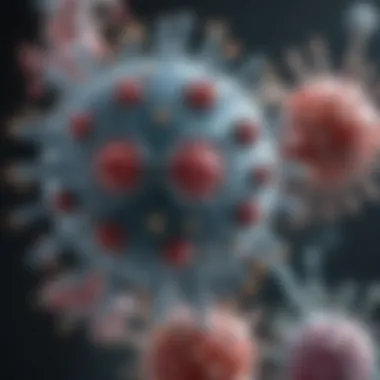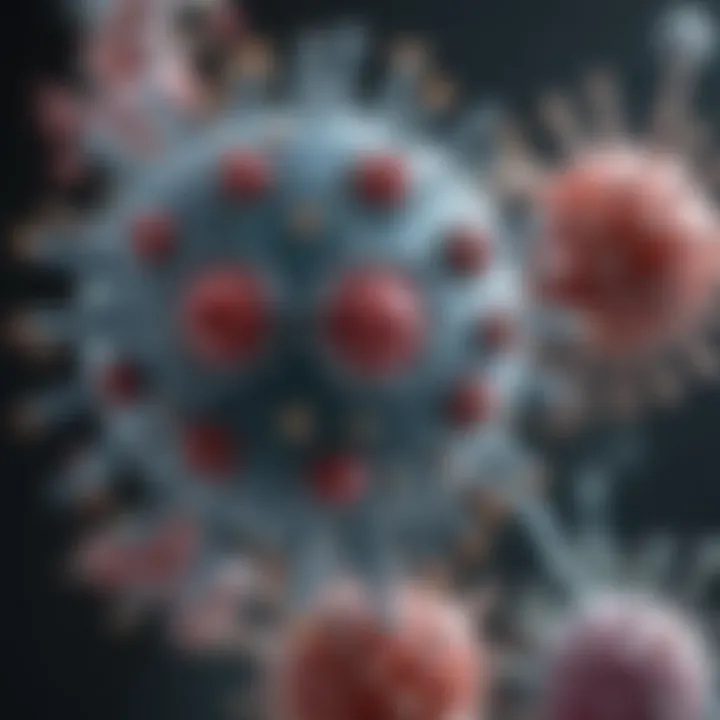Understanding Sinovac: Vaccine Technology Explained


Intro
Sinovac Biotech Ltd., a Chinese biopharmaceutical company, plays a pivotal role in the field of vaccine development. As the global health landscape shifts rapidly, understanding the nuances of Sinovac's vaccine technology is crucial. This article will unravel the intricacies of Sinovac's approach to vaccination, particularly its reliance on inactivated virus technology. By examining its mechanisms and comparing them to mRNA vaccines, we aim to provide clarity around Sinovac's role in health systems.
Article Overview
Purpose of the Article
The primary objective of this article is to delineate the specific characteristics of Sinovac's vaccine technology. We will investigate whether Sinovac represents a shift in vaccine development paradigms or remains rooted in traditional methodologies. The article will also delve into the implications of its technologies for public health strategies, especially during pandemics.
Relevance to Multiple Disciplines
Understanding Sinovac’s approach is significant across various fields, from public health policy to virology. By engaging in this comprehensive analysis, we will shed light on:
- The dynamics of vaccine development
- The importance of diverse vaccine platforms in public health
- The potential impact of Sinovac vaccines on global vaccination initiatives
Research Background
Historical Context
The landscape of vaccines has evolved significantly over the past century. Initially dominated by live attenuated and inactivated technologies, the introduction of mRNA technology marked a new era. Sinovac, established in 1998, has remained focused on using inactivated virus approaches to immunization. This background is essential to comprehend how Sinovac fits into today’s vaccination strategies.
Key Concepts and Definitions
- Inactivated Virus Vaccines: These vaccines use a virus that has been killed or inactivated. They can stimulate an immune response without the risk of causing disease.
- mRNA Vaccines: A newer vaccine technology that utilizes messenger RNA to instruct cells to produce a protein similar to that found in the virus, eliciting an immune response.
Sinovac's strategy highlights the importance of varied approaches to immunizations, especially in an age where rapid development is essential.
Sinovac's strategy highlights the importance of varied approaches to immunizations, especially in an age where rapid development is essential.
Through subsequent sections, we will analyze Sinovac’s vaccine efficacy, the results from clinical trials, and the overall impact on global public health. This thorough examination will furnish professionals, educators, and health policy makers with the insights required to assess Sinovac's contribution to vaccine technology.
Prelude to Vaccines
Vaccines are essential tools in modern medicine. They have significantly impacted public health by preventing diseases that once caused extensive morbidity and mortality. Understanding vaccines, including their mechanisms and benefits, is crucial when discussing specific vaccines like Sinovac. The importance of vaccines extends beyond individual protection; they contribute to community immunity and help manage public health crises.
Definition and Function of Vaccines
Vaccines are biological preparations that provide active acquired immunity to a particular infectious disease. Typically, a vaccine contains an agent that resembles a disease-causing microorganism. This agent is often made from weakened or killed forms of the microbes, its toxins, or one of its surface proteins. When introduced into the body, a vaccine stimulates the immune system to recognize the agent as foreign, destroy it, and remember it for future encounters.
The primary function of vaccines is to prepare the immune system to combat disease effectively. They train the body to recognize and fight pathogens, such as viruses and bacteria. By doing so, vaccines can drastically reduce the transmission of infectious diseases and maintain public health by preventing outbreaks.
Importance in Public Health
Vaccines play a critical role in global public health strategy. Their significance includes various aspects:
- Disease Prevention: Vaccines prevent diseases that could lead to serious health complications or death. They protect vulnerable populations, including infants, elderly, and immunocompromised individuals.
- Community Immunity: When a large portion of the population is vaccinated, it creates a herd immunity effect. This protects those who cannot be vaccinated due to health conditions, as the spread of disease is significantly reduced.
- Cost-Effective Healthcare: Vaccination programs are cost-effective. The costs of dealing with outbreaks often far exceed the costs associated with vaccination programs.
- Global Health Initiatives: Vaccines are fundamental for initiatives to eradicate diseases and improve health standards globally. They contribute to achieving goals set by organizations such as the World Health Organization.
"Vaccination is a simple, safe, and effective way of protecting people against harmful diseases before they come into contact with them."
"Vaccination is a simple, safe, and effective way of protecting people against harmful diseases before they come into contact with them."
In summary, understanding vaccines' principles sets the stage for analyzing specific examples, including Sinovac's technology. Effective vaccination programs can reshape public health landscapes, fostering healthier communities worldwide.
Sinovac: An Overview
The section on Sinovac serves as a foundational pillar of this article, aimed at elucidating various facets of the company and its vaccine technology. Recognizing Sinovac's significance in the global vaccine landscape is essential, especially as the world confronted the COVID-19 pandemic. The company's approach to vaccine development has implications for public health policy, vaccine accessibility, and the overall strategies adopted in immunization campaigns worldwide. Thus, a comprehensive understanding of Sinovac brings valuable insights into the mechanisms at play in modern vaccine technology.
Company Background and Development
Sinovac Biotech Ltd. was established in 2001, based in Beijing, China. The company has evolved from a modest biotech start-up into one of the leading developers of vaccines in Asia. It focuses on the research and development, production, and commercialization of vaccines. Sinovac is notable for its commitment to addressing the health challenges posed by infectious diseases through rigorous research and innovation.
Throughout its history, Sinovac has produced several vaccines, including those for hepatitis A, hepatitis B, and influenza. Each step of its development journey has demonstrated a strong emphasis on safety and efficacy. In the wake of the COVID-19 pandemic, Sinovac developed its inactivated virus vaccine, CoronaVac, which gained significant attention worldwide. This vaccine represented a concerted effort to leverage established methods to combat emerging health threats.
Sinovac's Vaccine Technology
Sinovac utilizes an inactivated virus platform for vaccine development. This technology involves using a virus that has been killed or inactivated so it cannot cause disease but still can provoke an immune response. The inactivated virus vaccine platform has several advantages, which include:


- Proven Efficacy: Traditional inactivated vaccines have a long history of use and have been proven effective against various pathogens.
- Stable Production: The process for creating inactivated vaccines is well understood, allowing for reliable mass production, especially critical during pandemics.
- Broad Immune Response: These vaccines can stimulate both humoral and cellular immune responses, potentially providing comprehensive protection against the infection.
Sinovac's CoronaVac, in particular, has shown robustness in clinical trials, demonstrating its capability to induce immune responses in diverse populations. Furthermore, regulatory approvals from countries across different continents highlight the vaccine's global acceptance and the company's commitment to transparency and public health.
"Understanding Sinovac’s approach aids in appreciating the intricate balance between traditional and modern vaccine technology used in combating pandemics."
"Understanding Sinovac’s approach aids in appreciating the intricate balance between traditional and modern vaccine technology used in combating pandemics."
In summary, Sinovac's integration of established vaccine technology with scientific rigor positions it as a significant player in the landscape of global vaccine development, allowing health authorities to bolster their immunization strategies effectively.
What is an mRNA Vaccine?
Understanding the intricacies of mRNA vaccines is crucial in the landscape of vaccine technology. This section outlines the fundamental aspects of mRNA vaccines, emphasizing their innovative characteristics and significant benefits in modern medicine.
Mechanism of Action
mRNA vaccines work by teaching cells how to produce a protein that triggers an immune response. Specifically, they use a piece of messenger RNA to encode instructions for cells to make a harmless protein unique to the virus that causes a disease, such as COVID-19.
Once the mRNA is injected into the body via a vaccine, it enters cells and utilizes the cell's machinery to produce this viral protein. The immune system then recognizes this protein as foreign and produces antibodies against it. This prepares the immune system to respond quickly and effectively if it encounters the actual virus in the future. This method offers a rapid development timeline compared to traditional vaccine approaches.
Some key points about the mechanism include:
- Speed: With initial research and design being computerized, mRNA technology allows for swift vaccine production.
- Precision: mRNA vaccines can be tailored quickly to specific viral mutations.
- Safety: As mRNA does not enter the cell nucleus, it does not interact with the host genome, reducing risks of genetic integration or mutation.
Examples of mRNA Vaccines
Several prominent mRNA vaccines have emerged in response to global health challenges, demonstrating their potential in infectious disease control. Among these, some notable examples include:
- Pfizer-BioNTech (Comirnaty): This vaccine was among the first to be authorized for emergency use against COVID-19. It showed impressive efficacy rates in clinical trials.
- Moderna (Spikevax): Another leading mRNA vaccine for COVID-19, it employs similar technology and has been pivotal in the fight against the pandemic.
- Other Candidates: Researchers are also exploring mRNA technology for a range of other vaccines, including those for flu and even cancer therapies.
These examples underscore the versatile application of mRNA technology in various therapeutic domains and its promise for future vaccine development.
Comparative Analysis: Sinovac vs. mRNA Vaccines
Comparing Sinovac with mRNA vaccines provides valuable insights into distinct vaccine technologies. Sinovac employs traditional inactivated virus methodology, while mRNA vaccines utilize a novel genetic approach. Understanding these differences is key for students, researchers, and professionals who are focused on vaccine efficacy and public health strategies.
Vaccine Platforms Explained
Sinovac, utilizing inactivated virus technology, involves growing the virus in the lab and then killing it. This method has been a staple in vaccine development for decades due to its longstanding history. The response generated by Sinovac's vaccine closely resembles a natural infection, prompting the immune system to learn how to fight off the real virus.
On the other hand, mRNA vaccines, like those developed by Pfizer-BioNTech and Moderna, introduce pieces of genetic material into the body. This material instructs cells to produce a harmless spike protein similar to the virus. The immune system then recognizes this protein as foreign and produces antibodies against it. Some key considerations in comparing these platforms include:
- Mechanism of Action: Sinovac leads to the production of antibodies through the inactivated virus, while mRNA prompts the body to create viral proteins that incite an immune response.
- Storage and Distribution: mRNA vaccines typically require colder temperatures for storage compared to Sinovac’s simpler refrigeration needs.
- Speed of Development: Both platforms have strong response times, however, mRNA vaccines can often be developed faster due to their flexible design.
Efficacy and Safety Profile Comparison
Assessing the efficacy and safety profiles of Sinovac and mRNA vaccines requires close examination of clinical trial data. Sinovac's vaccine has shown varying efficacy rates based on geographic location and population demographics.
For example, trials noted efficacy rates varying from 50% to 84%, influenced by factors such as age and preexisting health conditions. However, it successfully demonstrated the ability to prevent severe disease and hospitalization.
In contrast, mRNA vaccines generally report higher efficacy rates, usually above 90% against symptomatic disease. > "The difference in efficacy emphasizes the importance of understanding patient populations and specific health outcomes."
When it comes to safety, both vaccine types exhibit side effects, but the profiles differ slightly. Sinovac’s inactivated virus approach typically results in more mild to moderate reactions, such as soreness at the injection site and mild fever. In contrast, mRNA vaccines may cause more severe short-term side effects, although they are also considered safe.
In summary, understanding the comparative analysis of Sinovac against mRNA vaccines is crucial for a rounded perspective on vaccine technologies. For ongoing public health strategies, recognizing each option’s benefits and limitations can be instrumental in shaping future vaccination efforts.
Differences Between Inactivated and mRNA Vaccines
The distinction between inactivated vaccines and mRNA vaccines is essential to understanding different vaccine technologies. These differences influence not only the design and production of vaccines but also their mechanisms of action, safety profiles, and overall effectiveness. This section delves into the characteristics and implications of both approaches, shaping the public discourse on vaccines.
Traditional Vaccine Approaches
Inactivated vaccines, like the one developed by Sinovac, use killed or inactivated pathogens to stimulate an immune response. This approach has been in use for decades and has proven effective against various diseases. Some well-known inactivated vaccines include those for polio and hepatitis A.
Key features of inactivated vaccines:
- Stability and storage: Inactivated vaccines are generally more stable than their mRNA counterparts. They do not require the same stringent cold chain conditions.
- Immune response: These vaccines typically provoke a strong immune response, although it may be less robust compared to live-attenuated or mRNA vaccines. The immune system recognizes the inactivated virus and builds antibodies without the risk of causing disease.
- Multiple doses: Often, inactivated vaccines require multiple doses to ensure sufficient immunity, as seen with the Sinovac vaccine for COVID-19, which necessitates a two-dose regimen for maximum efficacy.
Given these properties, traditional vaccine approaches are well-timed for large-scale immunization efforts where established protocols are vital.


Innovative Properties of mRNA
mRNA vaccines represent a shift from traditional vaccination methods. They use a small piece of messenger RNA, which encodes a part of the pathogen, prompting the body to produce a protein that resembles what the virus would make. This, in turn, activates the immune system to recognize and combat the actual virus if encountered.
Notable attributes of mRNA vaccines:
- Rapid development: The mRNA platform allows for expedited vaccine development. Because it does not require the virus to be grown in a lab, as seen with inactivated vaccines, mRNA vaccines can be designed and manufactured swiftly.
- Strong immune response: They typically induce a robust immune reaction, including both humoral immunity (antibody production) and cellular immunity (T-cell activation), providing comprehensive protection.
- Fewer doses: Current mRNA vaccines are designed to maximize effectiveness often within just one or two doses, which can enhance acceptance and completion rates in vaccination programs.
Due to these innovative properties, mRNA technology has gained attention for its potential to tackle infectious diseases and possibly even cancers in the future.
Clinical Trials of Sinovac
Clinical trials are critical in the vaccine development process. They provide a structured framework to evaluate the safety and efficacy of a vaccine. Sinovac, like many other vaccine manufacturers, has undertaken various clinical trials. These trials are essential for determining how well the vaccine performs in diverse populations and under different conditions.
The importance of clinical trials for Sinovac cannot be understated. These studies help to establish the vaccine's safety profile, address public concerns, and ensure that the product meets regulatory standards. The results from these trials also play a significant role in public health decisions and vaccination strategies.
Study Design and Methodology
The study design for Sinovac’s clinical trials included several phases, each aiming to gather specific data about the vaccine's performance and safety. The trials began with preclinical studies, which involved laboratory tests and animal studies. Following successful outcomes, they moved to clinical phases I, II, and III.
In phase I trials, a small group of healthy volunteers received the vaccine. This phase mainly focused on assessing safety and identifying any immediate side effects. Phase II expanded this group, including individuals with different backgrounds and health conditions to further evaluate safety and immune response. Phase III trials included thousands of participants to robustly assess efficacy. This phase compared the vaccine group to a control group, allowing researchers to measure how effectively the vaccine prevented disease.
Data collection during these trials was meticulous. Researchers tracked various health markers and vaccine responses, compiling detailed records to analyze post-trial.
Results and Findings
The results from Sinovac’s clinical trials provided valuable insights. The primary outcome focused on the vaccine’s efficacy in preventing COVID-19 infections among participants. Findings indicated that Sinovac’s vaccine demonstrated a substantial effectiveness rate, though this varied based on demographics and comorbidities.
Generally, results showed:
- Efficacy rate: Reports indicated efficacy rates ranging from 50% to higher percentages depending on the specific study. This highlighted the vaccine's potential to reduce severe illness and hospitalization.
- Safety profile: Most participants experienced mild to moderate side effects, such as sore arms or fatigue. Serious adverse events were rare, which is a crucial aspect when considering vaccine rollout.
Clinical trial results serve not only to verify claims about efficacy but also to inform ongoing adjustments in public health strategies.
Clinical trial results serve not only to verify claims about efficacy but also to inform ongoing adjustments in public health strategies.
Furthermore, these findings were instrumental in discussions surrounding vaccine distribution and public trust. They provide a foundation for understanding Sinovac's role in broader vaccination efforts, especially in lower-resource settings. The commitment of Sinovac to transparency in sharing data enhances overall trust in vaccine initiatives.
Public Health Implications of Sinovac
The discussion around Sinovac's vaccine technology extends beyond its composition and efficacy. The public health implications are considerable and multifaceted. Understanding how Sinovac fits into the larger context of global vaccination efforts shapes the way we approach infectious disease control. This analysis emphasizes accessibility, distribution issues, and the overarching role of Sinovac in vaccination strategies aimed at mitigating outbreaks.
Accessibility and Distribution Challenges
Access to vaccines remains a challenge worldwide, and Sinovac's distribution can illustrate these complexities. One significant factor is the cost and logistics associated with getting this vaccine to regions with less infrastructure. Sinovac vaccines often require refrigeration, which can be hard to maintain in rural or underserved areas.
- Cost Factors: Sinovac vaccines are generally more affordable than some mRNA alternatives, making them an attractive option for nations with limited budgets.
- Cold Chain Necessities: A robust cold chain supply system is crucial for maintaining vaccine efficacy. Areas lacking this infrastructure may face hurdles in vaccine deployment.
- Manufacturing Capacity: Sinovac's collaborations with local manufacturers in different countries might improve accessibility. However, quality control remains a concern in these partnerships.
The ability to distribute vaccines effectively will determine the success rates of vaccination campaigns, especially in low- to middle-income countries. Without a careful strategy to address these distribution challenges, the potential of Sinovac could be diminished.
Role in Global Vaccination Efforts
Sinovac plays a pivotal role in the global landscape of vaccination against communicable diseases. Its inactivated virus technology offers a different route compared to mRNA vaccines, positioning it as a critical player, especially in Asia and Latin America.
- Complementary Strategy: In the context of global vaccination, Sinovac does not replace mRNA vaccines like Pfizer-BioNTech but complements them. Each type of vaccine provides options suited for different populations and needs.
- Public Trust: The acceptance of Sinovac vaccines is, in some cases, higher in regions familiar with traditional vaccine modalities. This trust can lead to improved vaccination rates, especially in hesitant populations.
- Distribution Networks: Collaborations with organizations like the WHO and GAVI have enabled Sinovac to be part of initiatives aimed at equitable global access. This active involvement ensures that more people can receive vaccinations in an efficient manner.
"The challenge lies not only in making vaccines available but in ensuring they reach those in need swiftly and efficiently."
"The challenge lies not only in making vaccines available but in ensuring they reach those in need swiftly and efficiently."
In summary, the public health implications of Sinovac’s technology are significant. Addressing accessibility, enhancing distribution networks, and understanding its global role can create a more effective response in dealing with infectious diseases. The focus must remain on collaborative strategies that leverage Sinovac's advantages in a diverse vaccine landscape.
Addressing Misconceptions
Misconceptions surrounding vaccines can significantly influence public perception and trust. In the case of Sinovac, several myths have emerged that tend to cloud its understanding and acceptance. Addressing these misconceptions is crucial because it shapes the public's response, ultimately affecting vaccination rates. This section aims to clarify common misunderstandings about Sinovac's technology, benefits, and safety.
Common Myths About Sinovac


One prevalent myth is that Sinovac's vaccine is not as effective as mRNA vaccines. Some critics argue that inactivated vaccines, such as the one developed by Sinovac, do not elicit a strong immune response. However, studies have shown that while the mechanisms may differ, the effectiveness of inactivated vaccines can be comparable under appropriate conditions.
Another misunderstanding is that all vaccines produced by Sinovac are of low quality. The company has undergone rigorous testing and regulatory scrutiny in various countries. In many instances, health authorities endorse its use following clinical trials demonstrating safety and efficacy.
Additionally, there are claims suggesting that using Sinovac's vaccine increases the risk of severe side effects. Most side effects are mild and temporary. Regulatory agencies continue to monitor vaccine safety closely, ensuring subjects receive adequate information pre and post-vaccination.
Clarifying the Science Behind Vaccines
Understanding how vaccines work is essential to combating myths. Vaccines activate the body's immune response without causing the disease. Sinovac uses inactivated virus technology, meaning it employs a virus that has been killed or weakened so it cannot cause illness.
- Immune Response: When vaccinated, the immune system recognizes the inactivated virus. It produces antibodies, preparing the body to fight off real infections in the future.
- Safety Profile: The inactivated virus approach has a long history of use, making it a reliable option. Regulatory bodies ensure extensive testing before public use.
- Efficacy: Efficacy can vary on several factors, including population demographics and the emergence of virus variants. However, existing data show Sinovac's vaccine significantly reduces illness severity and infection rates among those vaccinated.
Ultimately, clarifying the science behind vaccines helps dispel myths. It fosters informed decision-making among the public and emphasizes the importance of all vaccination strategies in public health efforts. The goal is not just to inform but also to build confidence in diverse vaccine technologies available.
The Future of Vaccine Development
The progression of vaccine technology is pivotal in the fight against emerging and re-emerging infectious diseases. As we analyze Sinovac along with similar entities, the understanding of future developments within this domain becomes apparent. Advancements promise to not only increase immunity against prevailing threats but also broaden the spectrum of disease prevention. Therefore, examining these upcoming trends is not just an academic endeavor but a necessary step toward improving global health outcomes and preparedness.
Emerging Technologies and Trends
The field of vaccine development continues to evolve rapidly. Several innovative technologies are on the horizon, which could potentially reshape the landscape of immunization.
- Vaccine Platforms: Traditional inactivated and live-attenuated vaccines are now complemented by promising new methods such as viral vector vaccines and mRNA technology. These platforms offer enhanced responsiveness to outbreaks and can be adapted quickly to new pathogens.
- Personalized Vaccines: There is a growing trend towards personalized medicine, where vaccines can be customized based on individual genetic makeup. This approach could lead to more effective immunizations tailored to fit the recipient’s immune response.
- Adjuvants and Delivery Methods: New adjuvants—substances that enhance the body’s immune response to an antigen—are being developed. These can improve efficacy at lower doses, potentially increasing access to vaccines. Additionally, innovative delivery mechanisms such as microneedle patches are being explored for easier administration.
The emphasis on enhancing efficacy and accessibility underlines the commitment of the scientific community to developing more effective vaccines. With thoughtful integration of these technologies, we may soon witness a breakthrough in our approach to infectious diseases.
"The ability to adapt technology in vaccine development underscores the relentless push towards better public health strategies and outcomes."
"The ability to adapt technology in vaccine development underscores the relentless push towards better public health strategies and outcomes."
Potential for Combination Vaccines
Combination vaccines present an attractive future pathway. Such vaccines can target multiple pathogens in a single shot, maximizing efficiency and coverage while reducing the overall burden on healthcare systems. This aspect is particularly crucial considering global vaccination drives like those against measles, mumps, and rubella—in which combination vaccines already play a vital role.
- Increased Efficiency: Combination vaccines reduce the number of injections a person must receive, which can enhance public compliance and overall vaccination rates.
- Greater Protection: By simultaneously offering protection against various diseases, combination vaccines strengthen herd immunity and lower the incidence of vaccine-preventable illnesses.
- Cost-Effectiveness: Developing and administering one vaccine instead of multiple agents can lead to cost savings for healthcare systems.
However, challenges remain, including ensuring adequate immune response to all antigens involved and monitoring for any potential negative interactions. As research progresses, it is essential to balance these considerations with the potential benefits that combination vaccines could yield.
In summary, the future of vaccine development is being shaped by technological advancements and innovative strategies. Understanding these elements can provide insights into how we can fortify public health initiatives and effectively combat infectious diseases.
Endings
The conclusion of an article serves as the final point of reflection on the major themes presented. In the context of this exploration of Sinovac, it consolidates the insights gleaned from earlier discussions, highlighting the dynamics of vaccine technology, particularly the distinction between mRNA and inactivated virus approaches.
The primary value of this section lies in its ability to synthesize the essential arguments put forth. It allows readers to see how each part contributes to a broader understanding of vaccination, particularly in relation to Sinovac. For instance, we examined Sinovac's inactivated virus technology and its implications on efficacy and safety. This examination is vital in framing the advantages and challenges facing vaccine developers.
Additionally, addressing misconceptions about Sinovac is a crucial part of our discussion. Readers are now better positioned to navigate through the landscape of vaccines and their respective technologies. This understanding is particularly relevant in the ongoing conversation about vaccine acceptance and public health strategies.
Overall, this concluding section adds considerable weight to the article, ensuring that readers grasp the necessary knowledge to appreciate the nuances of vaccine technology and its role in a global health framework.
Summarizing Key Insights
In summarizing the key insights from our analysis, we identify several critical points:
- Technology Distinction: There is a fundamental difference between mRNA and inactivated virus vaccines, each having its own merits and challenges.
- Efficacy Data: Clinical trials demonstrated significant efficacy for Sinovac, with results that underscore its potential in controlling outbreaks.
- Public Perception: Misunderstandings around vaccine efficacy and safety impact public trust and willingness to vaccinate.
- Global Access: Sinovac's role in making vaccines accessible to a wider population is crucial, particularly in lower-income regions.
These insights inform the overall understanding of Sinovac's role in vaccine development and the importance of public health initiatives.
The Importance of Diverse Vaccination Approaches
Diverse vaccination approaches are critical for several reasons:
- Variability in Response: Different populations may respond better to varied types of vaccines. An inclusive strategy ensures that more people benefit from a vaccine.
- Emerging Threats: As new pathogens emerge, adaptability in vaccine technology is necessary to address these threats effectively. Traditional inactivated vaccines and newer mRNA technologies complement each other in this regard.
- Herd Immunity: A robust vaccination strategy that includes multiple approaches helps achieve herd immunity, lower disease transmission rates, and ultimately protect vulnerable populations.
- Public Health Resilience: A diversified vaccine portfolio enhances public health resilience, making it less likely that health systems become overwhelmed during outbreaks.
In summary, recognizing and implementing a variety of vaccination strategies is not just a matter of preference but a fundamental principle of effective public health management.
Cited Works and Literature
The cited works and literature listed in this article provide foundational knowledge and insights into Sinovac, its vaccine technology, and broader vaccination efforts. Sources are selected based on their relevance, credibility, and contribution to the field. Academic articles, review papers, and official health organization reports enhance the content's depth and validate the claims made regarding Sinovac’s inactivated virus vaccines.
Here are some key categories of sources utilized in the article:
- Peer-Reviewed Journals: Articles from respected journals like Nature and The New England Journal of Medicine provide reliable data on clinical trials and vaccine effectiveness.
- Health Organization Publications: Guidelines and reports from the World Health Organization and the Centers for Disease Control and Prevention outline public health perspectives and vaccination strategies.
- Government and Regulatory Agency Reports: These sources offer details on the approval and distribution of vaccines, which are crucial for understanding Sinovac's impact.
These references will be meticulously cataloged at the end of the article for readers interested in pursuing additional information. The intention is to create a robust framework of knowledge that allows for informed discussions about Sinovac and its contributions to modern medical science.



